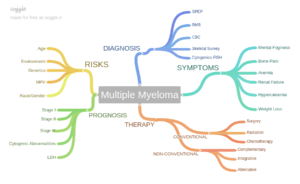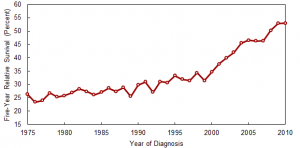There’s no cure for multiple myeloma, but treatment can bring it into remission, meaning you don’t have any sign of the disease…”
While reading an online FB Group of Multiple Myeloma patients recently, I came across a post from a patient stating that her oncologist told her that 10%-15% of MM patients were cured. Thinking that this MMer misunderstood her oncologist, I suggested that perhaps the oncologist was referring to “functional cures” and not actual cures.
No, she replied, many of these MMers had survived for more than 20 years. Her oncologist said they were cured!
While the studies below show that MM five-year survival averages have increased, and that young, early stage, low-risk NDMM patients can achieve 20 plus year survivals, MM remains an incurable blood cancer.
For conventional oncologists to state or even imply otherwise is selling false hope.
The MyelomaCrowd, WebMD, Myeloma Research News, MM survivor and blogger Gary Peterson and Kenshai Suzuki M.D. writing in International Journal of Hematology all agree. The five-year survival rate for MM is increasing. There are a growing number of MM survivors living for more than 20 years. But all MM survivors relapse eventually. All MM survivors eventually reach multi-drug resistance, end-stage and death.

Multiple Myeloma is an incurable blood cancer.
To state or even to imply otherwise is giving the newly diagnosed multiple myeloma patient and/or caregiver false hope.
Please don’t misunderstand me. MM therapies have improved greatly since I was first diagnosed with MM in early 1994. MM diagnostic testing has improved. Identification and treatment of MM symptoms and side effects such as:
- Bone damage,
- Kidney damage,
- heart damage,
- Hyperviscosity causing DVT, blood clots,
- Myelosuppression causing anemia, neutropenia, and thrombocytopenia,
- Chemobrain etc.
all have improved remarkably.
But standard-of-care or high-dose chemotherapy for newly diagnosed MM patients, according to study after study, does not cure multiple myeloma.
In my experience, standard-of-care, FDA approved therapies for MM are just too much toxicity for the average MM patient. Standard-of-care treatments are certainly too much toxicity for older MM survivors. And considering the average age of a NDMM patient is 69, most MM patients are elderly. Many have co-morbidities that can complicate their MM care.
The key then, again, in my experience, is to manage MM, not try to cure it. By this I mean that NDMM patients should undergo as little chemotherapy needed to put them into remission. When a relapse occurs, more chemo. But just enough to restore remission. Follow this process again and again.
Less chemotherapy means less toxicity. Less toxicity means fewer, less severe side effects. Less toxicity means a slower march toward multi-drug resistance.
David Emerson
- MM Survivor
- MM Cancer Coach
- Director PeopleBeatingCancer
Recommended Reading:
“Advances in the management of multiple myeloma (MM) led to a significant prolongation of overall survival (OS), mainly of the younger patients; almost 10% of them experience more than 10-year OS. Although long progression-free survival (PFS) correlates with extended OS, there is very limited information for the characteristics of patients who manage to be progression-free for a long period after first-line therapy…
In conclusion, our study in an unselected group of patients, the majority of whom did not participate in clinical trials, showed that 9% of patients with newly diagnosed myeloma experience prolonged PFS of more than 7 years (median: 10 years) even in the era of CC or first-generation novel agents.
These patients have low risk disease, mainly of ISS-1 or -2, no high-risk cytogenetics, no or mild renal impairment, and achieve deep responses after ASCT. These patients may be considered as “functionally” cured. The incorporation of novel treatment approaches may lead to a significant improvement in the probability of achievement of this “functionally” cured status.”
MyelomaCrowd
“New observational data from the United States National Cancer Institute’s Surveillance, Epidemiology, and End Results (SEER) shows that the survival rate for multiple myeloma has stabilized with little change within the past year. This is comparative to the sizable increases of survival rates within the last two years.
Five-Year Relative Survival of U.S. Multiple Myeloma Patients
By Year of Diagnosis

“Most researchers believe that the improvements in myeloma survival that have taken place over the past 15 to 20 years have been due to the introduction of new drugs to treat multiple myeloma.”
“What is a stage? When you’re first diagnosed with multiple myeloma, your doctor will assign it a number, called a stage, that describes how serious it is at that point. That number has a lot to do with the type of treatment your doctor will recommend and what you can expect from your disease going forward.
There’s no cure for multiple myeloma, but treatment can bring it into remission, meaning you don’t have any sign of the disease…”
“Prognosis refers to the likely outcome of a disease and the chance of it recurring.
Myeloma does not currently have a cure, but the prognosis of the disease has improved greatly in recent years due to the availability of treatments that can help in its effective management.
Several factors influence the prognosis of myeloma. These include prognostic indicators, survival statistics, myeloma staging,
minimal residue disease, and relapsed and refractory disease…”
“The SEER(Surveillance, Epidemiology, and End Results) data for multiple myeloma has been published in 2013 by the National Cancer Institute, and the average life expectancy remains at 4 years for the third year in a row.
However, some people beat the odds and live 10 to 20 years or more. When I was first diagnosed, the data for a person with dialysis-dependent kidney failure was just 3 months, and the overall average was 3 years. Now I am a 7 year and 10 month survivor, so I have beaten the average life expectancy prognosis at the time, and this was with what was called a negative prognostic indicator (kidney failure). So I believe you can break into two parts a patient’s ability to beat the odds….”
“Multiple myeloma (MM) is an incurable disease, and responsiveness to treatment varies among patients due to the high heterogeneity of the disease [1, 2]. The decision on which treatment is best for MM has been a difficult issue. However, treatment of MM has advanced remarkably in the past 10 years (Fig. 1). MM patients can achieve long-term remissions and survival [3,4,5,6,7,8,9]…”
“Multiple Myeloma is still considered an incurable disease despite the development of new therapy options. However, there is a small fraction of patients achieving a long- term remission (LTR) after induction therapy followed by high dose chemotherapy and autologous stem cell transplantation (ASCT).
Such patients that are still in complete remission or experience an indolent disease course over many years after high dose therapy are referred to as functionally cured.
To date, it is still unclear which patients experience a long term disease control…”




